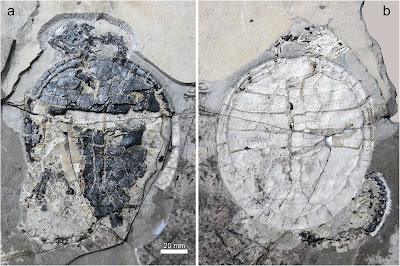Sinemydid Turtles are a group of extinct Turtles known from the Middle Jurassic to the Early Cretaceous of Asia. They have traditionally been thought to be stem-group Cryptodires (i.e. more closely related to the living Cryptodires, Turtles which can fully withdraw their heads into their shells, than to the living Pleurodires, Turtles that can partially hide their heads by folding them sideways within their shells), however some recent analyses have suggested that they might in fact be stem-group Chelonians (i.e. to have split from the lineage that led to both the Cryptodires and Pleurodires before the last common ancestor of the two groups) or stem-group Sea Turtles (more closely related to living Sea Turtles than to other Cryptodires).
In a paper published in the journal Nature: Scientific Reports on 10 November 2015, Chang-Fu Zhou of the Paleontological Institute at Shenyang Normal University and Márton Rabi of the Institut für Geowissenschaften at the University of Tübingen and Department of Paleontology and MTA – ELTE Lendület Dinosaur Research Group at Eötvös Loránd University, describe a new species of Sinemydid Turtle from the Early Cretaceous Jehol Biota of Inner Mongolia.
The new species is described from a single specimen, probably a subadult, preserved as part and counterpart on a split slab and showing exeptional preservation. It is named Xiaochelys ningchengensis, where 'Xiaochelys' means 'Small Turtle' and 'ningchengensis' means 'From Ningcheng', a reference to the Ningcheng Basin, where the specimen was found.
Xiaochelys ningchengensis from the Early Cretaceous Jehol Biota (Yixian Formation) of Ningcheng, Chifeng City, Inner Mongolia, northeastern China. Zhou & Rabi (2015).
This specimen was used to carry out a phylogenetic analysis of the relationships of Sinemydid Turtles, from which Zhou and Rabi conclude that this group are in fact Crown Group Turtles (a group defined as being all living Turtles, their most recent common ancestor, and everything descended from that ancestor), and that they are more closely related to the living Cryptodires than to the living Pleurodires.
See also...
 Turtle remains from the Late Miocene to Early Pliocene Black Rock Sandstone of Victoria, Australia. Australia has a diverse
assemblage of Sea Turtles today, with six of the seven living Sea
Turtle species found in Australian waters and one found nowhere else.
The continent also has an extensive fossil record...
Turtle remains from the Late Miocene to Early Pliocene Black Rock Sandstone of Victoria, Australia. Australia has a diverse
assemblage of Sea Turtles today, with six of the seven living Sea
Turtle species found in Australian waters and one found nowhere else.
The continent also has an extensive fossil record... Turtle eggs from the Late Cretaceous of Madagascar. Turtles are
unique among living Amniotes (Vertebrates that can lay...
Turtle eggs from the Late Cretaceous of Madagascar. Turtles are
unique among living Amniotes (Vertebrates that can lay... Pappochelys rosinae: A Proto-Turtle from the Middle Triassic of Badem Württemberg, Germany. Turtles
have a fairly good fossil record, as would...
Pappochelys rosinae: A Proto-Turtle from the Middle Triassic of Badem Württemberg, Germany. Turtles
have a fairly good fossil record, as would...
Follow
Sciency Thoughts on Facebook.

